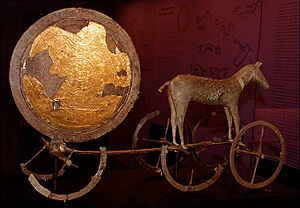Sól facts for kids

Sól (pronounced "Soul") is a very important figure in Germanic mythology. She is the Sun herself, but imagined as a person. In Norse mythology, Sól is described in two famous old books: the Poetic Edda and the Prose Edda. The Poetic Edda was written in the 13th century, using even older stories. The Prose Edda was also written in the 13th century by a writer named Snorri Sturluson.
Contents
Who is Sól?
Sól is the goddess of the Sun in Norse mythology. She brings light and warmth to the world every day. Imagine the Sun not just as a giant star, but as a powerful being who guides it across the sky. That's Sól! She is a key part of the ancient beliefs of the Germanic people, especially those in Northern Europe, like the Vikings.
Sól in Ancient Stories
We learn most about Sól from two main sources:
- The Poetic Edda: This is a collection of old Norse poems. It tells us many stories about the gods, heroes, and the world they lived in.
- The Prose Edda: This book was written by Snorri Sturluson around the year 1220. It helps us understand the poems and explains many myths in more detail.
These books describe Sól as a goddess who is always moving.
Sól's Journey Across the Sky
In Norse myths, Sól rides across the sky each day in a chariot. This chariot is pulled by two magnificent horses named Árvakr and Alsviðr. They gallop quickly, bringing the Sun's light to everyone.
But Sól's journey isn't always peaceful! She is constantly chased by a giant wolf named Sköll. Sköll wants to catch and swallow the Sun. Another wolf, Hati, chases the Moon. This chase explains why the Sun and Moon are always moving across the sky.
What Happens at Ragnarök?
The myths say that one day, during a great event called Ragnarök, Sköll will finally catch Sól. This event marks the end of the world as the Norse gods knew it. However, the stories also say that after Ragnarök, Sól's daughter will take her place. This new Sun will bring light to a new, reborn world. This shows that even after an ending, there is always a new beginning.
The Sun's Importance in Daily Life
For the ancient Norse people, the Sun was incredibly important. It meant warmth, light, and life. Without the Sun, crops wouldn't grow, and the world would be dark and cold. Sól was seen as a protector and a bringer of good things. Her daily journey was a reminder of the cycle of day and night, and the constant movement of time.

